
Concept explainers
Assume
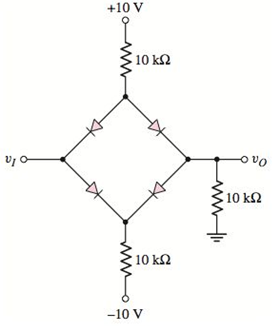
Figure P2.51
To plot: The output voltage,
Explanation of Solution
Given:
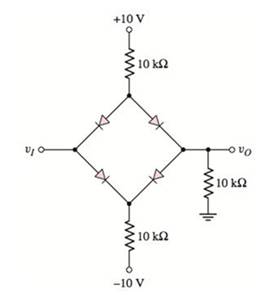
Calculation:
Case 1:
Assume that diodes

Figure 1
Apply the Kirchhoff’s voltage to the outer branch of the circuit shown in figure 1.
Therefore,
The voltage at node
The voltage at node
Apply the Kirchhoff’s voltage to the input branch of the circuit shown in figure
Therefore,
The voltage at node
The diode
The diode
Therefore, diodes
The output voltage is constant for
Case 2:
Assume that diodes
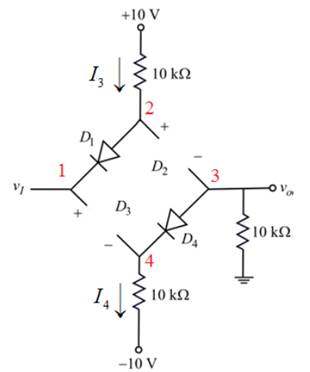
Figure 2
Apply the Kirchhoff’s voltage to the outer branch of the circuit shown in figure 2.
The voltage at node
The voltage at node
Apply the Kirchhoff’s voltage to the input branch of the circuit shown in figure 2.
Therefore,
The voltage at node
The diode
The diode
Therefore, diodes
Therefore, the output voltage is constant for
Case 3:
Assume that diodes
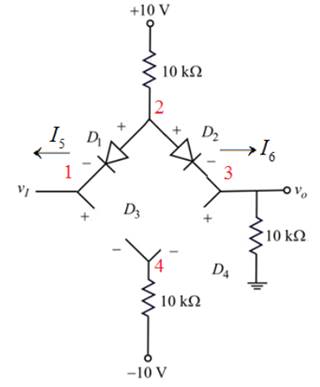
Figure 3
Apply the Kirchhoff’s current law at node
The diode
Apply the Kirchhoff’s voltage law to the input branch of the circuit shown in figure 3.
The voltage across diode
Consider equation(1).
Rewrite as,
Therefore, the output voltage is,
Therefore, plot
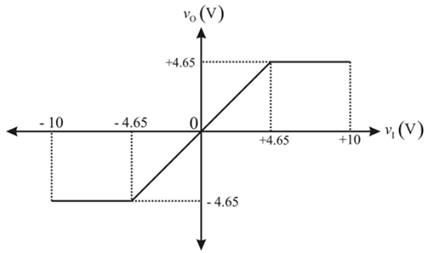
Conclusion:
Therefore, plot of
Want to see more full solutions like this?
Chapter 2 Solutions
MICROELECT. CIRCUIT ANALYSIS&DESIGN (LL)
- "I need an expert solution because the previous solution is incorrect." An antenna with a radiation impedance of 75+j10 ohm, with 10 ohm loss resistance, is connected to a generator with open-circuit voltage of 12 v and an internal impedance of 20 ohms via a 2/4-long transmission line with characteristic impedance of 75 ohms. (a) Draw the equivalent circuit (b) Determine the power supplied by the generator. (c) Determine the power radiated by the antenna. (d) Determine the reflection coefficient at the antenna terminals.arrow_forward--3/5- b) g(t) = 3 1441 g(t+mT) = g(t) -31 (i) Complex fourier coefficient Cn. (ii) Complex fourier coefficients - real fourier coefficient (the first 5 non-zero terms) of (iii) sketch the amplitude spectrum g(t) |Cal against n. n= -3 ⇒n=3 (labelling the axis).arrow_forwardQ4) (i) Calculate the fourier transform of : h(t) 2T (is) h(t) 2T -T о T 2T ·(-++T). cos2t ost≤T (iii) hro (4) ((-++T). cos otherwisearrow_forward
- Q2)a) consider the Circuit in figure 2 with initial conditions of Vc (o) = 5V, I₁ (o) = 1A, (i) redraw the circuit in the frequency domain using laplace Wansforms. (ii) using this circuit derive an equation for the Voltage across the inductor in the time domain.. 3.12 ww =V/3F ZH (figure 2) d) Solve the following second order differential equation using laplace transforms. d12 + 5 dx 3x=71 dt - with initial conditions x² (0) = 2, α(0) = 1arrow_forwardb) Another periodic waveform is defined by T c) g(t)= T with g(t+mT) = g(t) and m is an integer. (i) Sketch g(t) over two full cycles in the time domain, labelling the axes. (ii) Derive the formulae for the complex Fourier coefficients c₁ for g(t). For a periodic waveform h(t), if its complex Fourier coefficients are T T when n is odd T 2n²² T 4nn when n is even and not zero 4nn please derive the first five non-zero terms of the real Fourier series for h(t).arrow_forwardQ3)α) f(t) = (-+- 1 Isto f(t+mT) = f(t). L+- I Ost ST integer (i) sketch f(t) 2 full cycles time domain. (labelling the axis). (ii) Derive the formula for the real fourier Coefficients (i) Real Fourier series f(t), first 5 non-terms. an bn for f(t).arrow_forward
- Q3. a) A periodic waveform is defined by T 3 0≤t< f(t) = SIarrow_forwardQ2. a) Sketch the following waveform f(t)=Vo -1/2≤t≤1/2 =0 otherwise and show that its Fourier transform is 2V ωτ ωτ F(s)-sinotsinc) 2 Use this result to sketch a fully labelled graph of the amplitude spectrum of a single square voltage pulse, of amplitude 24V and pulse width 1.4μs, using units of Hz for the frequency axis. (Note: graph paper is not required - a clear, fully-labelled sketch is adequate).arrow_forwardc) Another periodic waveform is defined by 4t g(t)= 0≤tarrow_forwardQ1. a) A periodic waveform is defined by f(t)= 3 0≤tarrow_forwardI have 50mV in the function generator with 10kHz. Does the connection and reading seem about right? I need to read output voltage.arrow_forwardThe solution sent previously is incorrect; I need the correct solution. An antenna with a radiation impedance of 75+j10 ohm, with 10 ohm loss resistance, is connected to a generator with open-circuit voltage of 12 v and an internal impedance of 20 ohms via a 2/4-long transmission line with characteristic impedance of 75 ohms. (a) Draw the equivalent circuit (c) Determine the power radiated by the antenna.arrow_forwardarrow_back_iosSEE MORE QUESTIONSarrow_forward_iosRecommended textbooks for you
 Diodes Explained - The basics how diodes work working principle pn junction; Author: The Engineering Mindset;https://www.youtube.com/watch?v=Fwj_d3uO5g8;License: Standard Youtube License
Diodes Explained - The basics how diodes work working principle pn junction; Author: The Engineering Mindset;https://www.youtube.com/watch?v=Fwj_d3uO5g8;License: Standard Youtube License